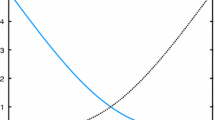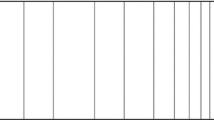Abstract
The paper presents a mathematical model for calculating the nonisothermal moisture transfer in porous building materials. The simultaneous heat and moisture transfer problem was modeled. Vapor content and temperature were chosen as principal driving potentials. The coupled equations were solved by a numerical method. An experimental methodology for determining the temperature gradient coefficient for building materials was also proposed. Both the moisture diffusion coefficient and the temperature gradient coefficient for building material were experimentally evaluated. Using the measured moisture transport coefficients, the temperature and vapor content distribution inside building materials were predicted by the new model. The results were compared with experimental data. A good agreement was obtained.













Similar content being viewed by others
Abbreviations
- C m :
-
Specific moisture (m3 kg−1)
- C p :
-
Specific heat (dry material) (J kg−1 K−1)
- D T :
-
Thermal diffusion coefficient due to the temperature gradient (kg m−1 K−1 s−1)
- h lv :
-
Heat of phase-change (J kg−1)
- j :
-
Moisture flow (kg m−2 s−1)
- k p :
-
Permeability (m2)
- l :
-
Thickness of the specimen (m)
- M w :
-
Molar weight of water (g mol−1)
- P w :
-
Pore water pressure (Pa)
- R :
-
Gas constant (J K−1 mol−1)
- s :
-
Laplace transformation parameter
- t :
-
Time (s)
- T :
-
Temperature (K)
- v :
-
Vapor content (kg m−3)
- v s :
-
Vapor content at saturation (kg m−3)
- α:
-
Convective heat transfer coefficient (W m−2 K−1)
- β:
-
Convective moisture transfer coefficient (m s−1)
- γ:
-
Heat of absorption or desorption (kJ kg−1)
- ɛ:
-
Thermogradient coefficient (kg m−3 K−1)
- λ:
-
Thermal conductivity (W m−1 K−1)
- ρ:
-
Density of the materials (dry condition) (kg m−3)
- ρw :
-
Density of water (kg m−3)
- φ:
-
Transformation function
- σ:
-
Phase-change criterion
- η:
-
Viscosity (kg m−1 s−1)
- δ:
-
Moisture diffusion coefficient (m2 s−1)
- δv :
-
Vapor flow coefficient (m2 s−1)
- b:
-
Initial condition
- i:
-
Isothermal case
- l:
-
Liquid
- t:
-
Nonisothermal case
- v:
-
Vapor
References
Luikov AW (1966) Heat and mass transfer in capillary-porous bodies. Pergamon Press, Oxford
Philip JR, De Vries DA (1957) Trans Am Geophys Union 38(2):222
Pedersen CR (1992) Build Environ 3:387. doi:https://doi.org/10.1016/0360-1323(92)90038-Q
Künzel HM (1995) Simultaneous heat and moisture transport in building components: one- and two-dimensional calculation using simple parameters. IRB Verlag, Stuttgart
Milly PCD (1980) The coupled transport of water and heat in a vertical soil column under atmospheric excitation. Ph.D. Thesis, Massachusetts Institute of Technology, Massachusetts
Janssen H, Carmeliet J, Hens H (2002) J Therm Envelope Build Sci 25(4):275
Crausse P (1983) Etude fondamentale des transfers couplés de chaleur et d’humidité en milieu poreux non saturé. Dissertation, Institut National Polytechnique de Toulouse
Häupl P, Stopp H, Strangfeld P (1988) Bauzeitung 42(3):113
Kari B, Perrin B, Foures JC (1992) Modélisation macroscopique des transferts de chaleur et d’humidité dans des matériaux du bâtiment. Manuskript zur Veröffentlichung in RILEM, Université de Toulouse
Da Cunha Neto J, Daian JF (1991) Experimental analysis of moisture transport in consolidate porous media under temperature gradient. International seminar on heat and mass transfer, Dubrovnik
Mikhailov MD, Ozisik MN (1984) Unified analysis and solutions of heat and mass diffusion. Wiley, New York
Qin M, Belarbi R, Aït-Mokhtar A, Seigneurin A (2006) Int Commun Heat Mass Transfer 33(1):39. doi:https://doi.org/10.1016/j.icheatmasstransfer.2005.08.001
Nilsson L-O (2004) Moisture transport in cementitious materials – theory and some experimental results. In: Knud Højgaard Conference on Advanced Cement-Based Materials – Research and Teaching, Technical University of Denmark
Künzel HM (1994) One and two-dimensional calculation of the simultaneous heat and moisture transport in building components, using simple parameters. Ph.D. thesis, Frauenhofer Institute for Building Physics
Tao WQ (1988) Numerical heat transfer (in Chinese). Xian Jiao Tong University Press, Shanxi
Qin M (2007) Study of the hygrothermal transfer phenomenon in building envelopes. Ph.D. thesis, University of La Rochelle, France
Janz M (2000) Moisture transport and fixation in porous materials at high moisture levels. Ph.D. thesis, Lund University, Sweden
Johansson P (2005) Water absorption in two-layer masonry systems. Ph.D. thesis, Lund University, Sweden
Author information
Authors and Affiliations
Corresponding author
Rights and permissions
About this article
Cite this article
Qin, M., Belarbi, R., Aït-Mokhtar, A. et al. Simultaneous heat and moisture transport in porous building materials: evaluation of nonisothermal moisture transport properties. J Mater Sci 43, 3655–3663 (2008). https://doi.org/10.1007/s10853-008-2584-3
Received:
Accepted:
Published:
Issue Date:
DOI: https://doi.org/10.1007/s10853-008-2584-3




